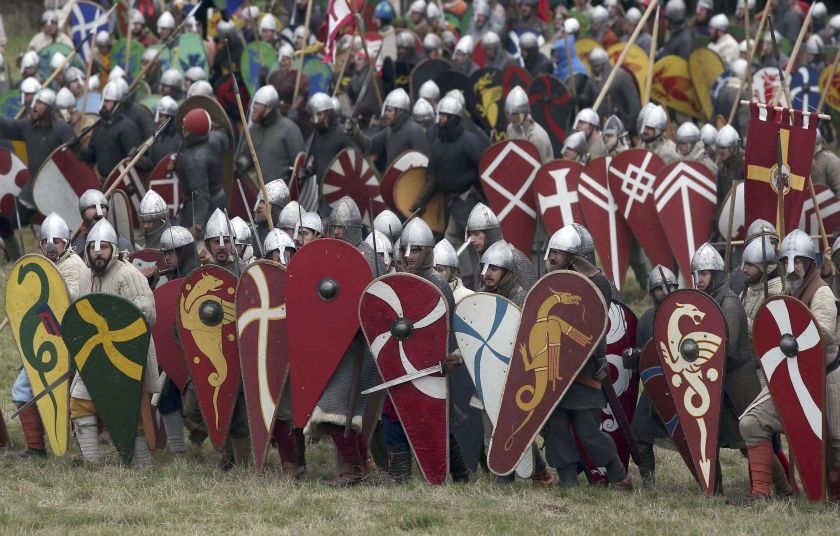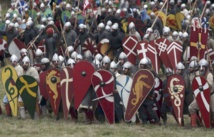The battle was a decisive moment in English history, with Harold's death in the onslaught ushering in a period of Norman rule as William seized the throne.
"The battlefield is as it was. It's very rare, it is as if you were fighting at (the World War I battle of) Verdun," said Michael Sadde, who participated in the re-enactment.
"Such land elsewhere has been concreted over. Here it has been preserved for 950 years."
Sporting a red and yellow cape and mid-length black hair, Sadde was portraying William for a third straight year at the annual event in the small town of Battle, near Hastings.
Except for a row of portable toilets and a BBC camera, everything immediately surrounding Sadde was as it would have been on October 14, 1066.
On the side of the Saxons, Peter Flowerdew, 66, with white locks and a goatee beard, set about crafting an axe out of wood.
By his side, in front of a white linen tent, two men busied themselves around a cauldron: one preparing lunch, a thick piece of bread covered in meat, while the other toasted him with mead.
There were no showers on the scene, these fans of the Middle Ages boasted -- nor any electricity or even potatoes, bananas or tomatoes, all of which were introduced later into Europe.
- Invasion by ferry -
On the Norman side, a couple butchered a deer to be cooked in a stew, while a group of French people conversed around a fire at the bottom of the encampment.
The men wore pitch-coated linen cloths and cotton tunics, sometimes under heavy chain mail armour, while a red-haired woman wore a fox fur around her neck.
All of the participants dedicate several hours a week to their passion, training themselves in sword fighting.
Some members of the group are even planning to reproduce a ship from the period. But alas, this year the invaders took the Calais-Dover ferry, and even had to present their passports, they joked.
King Harold II appeared suddenly from the other side of the battlefield, with a pointed helmet upon his head.
A biology teacher during the week, Kendall Kinrade headed an army of about 500 men on Saturday. Was he thinking of Brexit as he tried to repel the Normans?
"I have to say, having an election is a better way to decide these things than fighting," said Kinrade, smiling.
From a historical perspective, the building of Europe is a recent project, noted Flowerdew, a psychotherapist by day.
The Battle of Hastings, which overturned the political balance of western Europe, "goes back longer than that," added Flowerdew. "Almost a thousand years."
-----------------------------------------------------------------------------------------------------------------------
"The battlefield is as it was. It's very rare, it is as if you were fighting at (the World War I battle of) Verdun," said Michael Sadde, who participated in the re-enactment.
"Such land elsewhere has been concreted over. Here it has been preserved for 950 years."
Sporting a red and yellow cape and mid-length black hair, Sadde was portraying William for a third straight year at the annual event in the small town of Battle, near Hastings.
Except for a row of portable toilets and a BBC camera, everything immediately surrounding Sadde was as it would have been on October 14, 1066.
On the side of the Saxons, Peter Flowerdew, 66, with white locks and a goatee beard, set about crafting an axe out of wood.
By his side, in front of a white linen tent, two men busied themselves around a cauldron: one preparing lunch, a thick piece of bread covered in meat, while the other toasted him with mead.
There were no showers on the scene, these fans of the Middle Ages boasted -- nor any electricity or even potatoes, bananas or tomatoes, all of which were introduced later into Europe.
- Invasion by ferry -
On the Norman side, a couple butchered a deer to be cooked in a stew, while a group of French people conversed around a fire at the bottom of the encampment.
The men wore pitch-coated linen cloths and cotton tunics, sometimes under heavy chain mail armour, while a red-haired woman wore a fox fur around her neck.
All of the participants dedicate several hours a week to their passion, training themselves in sword fighting.
Some members of the group are even planning to reproduce a ship from the period. But alas, this year the invaders took the Calais-Dover ferry, and even had to present their passports, they joked.
King Harold II appeared suddenly from the other side of the battlefield, with a pointed helmet upon his head.
A biology teacher during the week, Kendall Kinrade headed an army of about 500 men on Saturday. Was he thinking of Brexit as he tried to repel the Normans?
"I have to say, having an election is a better way to decide these things than fighting," said Kinrade, smiling.
From a historical perspective, the building of Europe is a recent project, noted Flowerdew, a psychotherapist by day.
The Battle of Hastings, which overturned the political balance of western Europe, "goes back longer than that," added Flowerdew. "Almost a thousand years."
-----------------------------------------------------------------------------------------------------------------------









 Home
Home Politics
Politics











